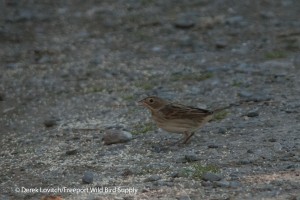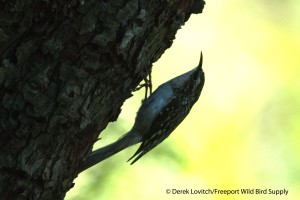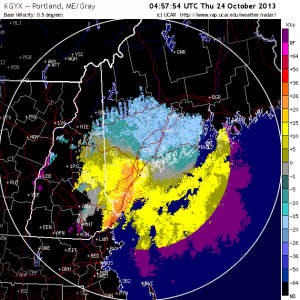This past weekend was my annual “MonhegZEN Migration Weekend.” A small group – absolutely no more than eight people per day – joins me on a per diem basis to enjoy the wonder of fall migration at this offshore hotspot. While the 105 total species was right about my Fall Weekend average, it did include 20 species of warblers, and a variety of the usual fall-on-Monhegan cast of characters. And a few “good” birds as always.
But before I get into the daily rundown, let me post a quiz. Here are the 1am radar and velocity images from each of the four nights preceeding each of my four days on the island. Can you guess which days had the most birds?








If you said the first two had more birds than the second two, you would be absolutely right! And yes, Saturday (Day 2) was definitely the best day for migrants on the island. And yes, Monday (Day 4) was very, very slow. The radar certainly suggested it, and our birding over the course of each day definitively ground-thruthed it.
 Leaving Port Clyde, 9/26.
Leaving Port Clyde, 9/26.
After the good flight on Thurday night into Friday morning, I arrived with part of my group from Port Clyde on the 7am ferry, dropping us on the island just before 8. The birding was still going strong. In fact, it took us almost an hour and a half just to walk to the end of Dock Road (about ¼ mile)! At least six Cape May Warblers in one cluster of spruces, Rusty Blackbirds were overhead (including one just as our boat docked, a nice welcome to the island), and then a buzz-by from a Cooper’s Hawk.
Common on the mainland, Coops are rather rare this far offshore, and I don’t see them on the island every fall, so this was a real treat – and an “Island Bird” for a friend I was exchanging info with. A short while later we caught up with the last individual of what was once 5 Broad-winged Hawks that drifted to the island – only my second-ever out here. A Yellow-billed Cuckoo, a continuing Lark Sparrow, Clay-colored Sparrow, and Dickcissel – yup, most of the usual fall Monhegan “trash birds!”
 Lark and White-throated Sparrows
Lark and White-throated Sparrows
 Very pale juvenile Dickcissel
Very pale juvenile Dickcissel
 Clay-colored Sparrow.
Clay-colored Sparrow.
Honestly however, the bird of the day – from an island rarity perspective – was probably House Sparrow. Seriously. A male that apparently landed on the Hardy Boat half way to the island a few days prior had taken up residence here. Were a female to show up – almost certainly in similar fashion – then we could have an issue <insert ominous foreshadowing music here>.
The morning flight was hot and heavy on Saturday morning. In fact, there was so much overhead that we barely left the grounds of the Trailing Yew before breakfast. All we could do was stand around, look up, and marvel at the wonders of migration. Hundreds of Yellow-rumped Warblers, 10’s of Palm Warblers, oodles of Golden-crowned and Ruby-crowned Kinglets…2-3 Blue-gray Gnatcatchers, another Dickcissel or two, and a fly-by Blue Grosbeak (the first on the island this fall?) – it would have been overwhelming to quantify, but luckily, when I am away from SandyPoint, I am not nearly as compulsive. Phew.


This Blue-gray Gnatcatcher visited us while we were dining on Novelty pizza.
 Brown Creepers were common, and unusually photogenic, throughout the day.
Brown Creepers were common, and unusually photogenic, throughout the day.
Good birding continued throughout the day. We confirmed a Nelson’s Sparrow in the marsh at Lobster Cove and found a Marsh Wren. We tallied 17 species of warblers over the course of the day. It was warm. It was calm. It was simply perfect!
But we all agreed that the highlight was the afternoon on White Head. A light southeasterly breeze produced a light updraft off of the cliffs, and Peregrine Falcons were taking full advantage. Some birds were swirling around, doing little more than what could be described only as “playing” in the wind. Some birds were undoubtably passage migrants getting a quick lift from the rising warm air. We know there were at least six Peregrines, as we had a bona-fide kettle of six swirling together at one point. Normally, the hawkcounter in me swings into action. But alas, this is MonhegZEN birding, so I just sat back and enjoyed the show.




 (Photo (c) K. Lindquist).
(Photo (c) K. Lindquist).
Sea- and Hawk-watching from White Head. Lots of eye-to-eye Peregrine Falcons, an Opsrey, and a distant Minke Whale or two.
A shroud of fog enveloped the island on Sunday morning, but there weren’t too many birds overhead to be obscured by it. Although there were few birds overhead or moving around once the fog lifted, there was still an ample supply of Yellow-rumped Warblers and Golden-crowned Kinglets. We happened upon a Prairie Warbler, and added a few other species to our trip list, such as two Ruby-throated Hummingbirds, and – finally – Ring-necked Pheasants (how did I go two days without hearing or seeing a pheasant here?). Lark Sparrow, Yellow-billed Cuckoo, Rusty Blackbird, Least Flycatcher (finally, after three days I had an Empid to try and string!)…the list goes on. But overall, birding was decidedly slower than the previous two days (note what constitutes a slow day on Monhegan!), and rather warm.



While the birding was slow, we took time to enjoy the scenery in the fog.
Remember when I said that all that male House Sparrow needed was a female to arrive? Uh-oh.

I am unsure how long it’s been – if ever? – since two House Sparrows were on the island. While only die-hard island-listers appreciated these birds as much as I did (I remain captivated by the way birds – all birds – find their way to islands and what their lives are like once they get there ), the members of my group that have birded here before at least understood the significance, and potential colonization consequences of this sighting.
Luckily, we had other intrigue to talk about as well. The spruces along Dock Road were happenin’ again today, but one warbler in particular occupied us for a while. I first called it a Blackburnian, and then I back-tracked…a lot. It was so impressively pale, and feeding above us, some of the most diagnostic features were not visible. We spent about a half hour with this bird, which eventually obliged us as it fed in the lowest boughs of the tree. We worked it carefully and thoroughly, taking the opportunity to really learn from this individual. It took a while, but I was finally convinced it was a Blackburnian in large part due to the very pale but distinct “braces” on the back, and what we would (via camera-screen “instant replay”) finally confirm as a small, pale orange central forehead stripe.



The orange feet seem odd to me, and the dark auriculars appeared much more contrasting on these photos than we interpreted it in the field. This was a good “learning and teaching bird,” and therefore this was one of my favorite birds of the trip.

I visited the Monhegan Brewing Company a couple of times for good beer and conversation. And we know good business can be conducted over a beer. In fact, during my last beer there on Sunday evening, I struck a deal with Sue to buy the sunflower heads from the Island Farm. They’re currently drying at our house, but they’ll soon be for sale here at the store. The money will go to help the Island Farm in their pursuit to provide a sustainable source of produce for the island. The gardens are also great birding!


Very few birds were on the move Sunday night, and with almost nothing visible on the radar, I didn’t exactly pop out of bed in the morning. I did get out for a little while before breakfast, however, and once again the morning flight – or lack thereof – proved what the radar suggested. My tour had come to an end, but I elected to stay out for the day to bird with my friend Kristen. We both just wished there were a few more birds to see!


Although I like the photo on the left of the Yellow-rumped Warbler atop a Red Spruce, as you can see on the right, I excel at photographs of fuzzy twigs.
 A most impressive Fringed Gentian.
A most impressive Fringed Gentian.
We worked the bush hard, checking all sorts of seldom-searched nooks and crannies. Some of our totals for the day were higher than previous days simply because we covered more ground. The Clay-colored and Lark Sparrows continued, as did the two Green-winged Teal in the town marsh. A spiffy Chestnut-sided Warbler was my 20th species of warbler for the weekend, and we added a few more waterbirds to the list by dedicating some time to sea-watching and scanning the gulls in the harbor.
Unfortunately, most of the afternoon – following one last pizza – was spent keeping an eye on our watches and watching our time rapidly tick away. At least we weren’t nursing a concern about leaving hot and heavy birding – it was slow, very slow, today, and that did make our departure a little less unwelcome. A little; it’s never easy to leave this magical place.


Trap Day!
Here’s my weekend’s checklist, with estimates or counts of each species per day (not including ferry):
Mallard: 12, 12, 12, 12
American Black Duck: 1, 1, 1, 5
Green-winged Teal: 1, 1, 2, 2,
Common Eider: x, x, x, x
Surf Scoter: 0, 0, 0, 4
Ring-necked Pheasant: 0, 0, 3, 2
Common Loon: 3, 2, 1, 1
Red-necked Grebe: 0, 1, 0, 0
Great Cormorant: 1, 5, 1, 7
Double-crested Cormorant: x,x,x,x
Northern Gannet: 0, 125, 8, 30
Great Blue Heron: 1, 1, 1, 0
Osprey: 0, 2, 0, 0
Bald Eagle: 2, 2, 2, 2
Northern Harrier: 1, 1, 0, 0,
Sharp-shinned Hawk: 6, 5, 5, 4
COOPER’S HAWK: 1,0,0,0
BROAD-WINGED HAWK: 1,0,0,0
American Kestrel: 2, 2, 1, 1
Merlin: 15, 8, 4, 3
Peregrine Falcon: 8, 12, 1, 1
Semipalmated Plover: 2, 0, 1, 0
Laughing Gull: 0, 0, 0, 2
Ring-billed Gull: 0, 0, 0, 1
Herring Gull: x,x,x,x
LESSER BLACK-BACKED GULL: 0, 0, 0, 2
Great Black-backed Gull: x,x,x,x
Black Guillemot: 10, 20, 10, 15
Mourning Dove: 3, 3, 3, 3
YELLOW-BILLED CUCKOO: 1, 0, 1, 0
Ruby-throated Hummingbird: 0, 0, 2, 2
Belted Kingfisher: 1, 0, 1, 1
RED-BELLIED WOODPECKER: 1, 0, 0, 0
Yellow-bellied Sapsucker: 25, 50, 25, 20
Downy Woodpecker: 0, 1, 1, 1
Northern Flicker: 20, 15, 25, 20
Eastern Wood-Pewee: 0, 1, 0, 0
Least Flycatcher: 0, 0, 1, 0
Eastern Phoebe: 8, 5, 3, 1
Red-eyed Vireo: 30, 20, 18, 12
Blue-headed Vireo: 12, 20, 25, 6
Blue Jay: 6, 10, 8, 8
Common Raven: 2,2,2,2
American Crow: x,x,x,x
Black-capped Chickadee: 20, 15, 15, 20
Red-breasted Nuthatch: 6, 15, 10, 8
Brown Creeper: 15, 35, 20, 3
Carolina Wren: 5, 8, 10, 12
House Wren: 0, 1, 1, 0
Winter Wren: 1, 1, 1, 1
Marsh Wren: 0, 1, 1, 1
Golden-crowned Kinglet: 15, 75, 50, 35
Ruby-crowned Kinglet: 25, 40, 25, 15
BLUE-GRAY GNATCATCHER: 1, 2-3, 2, 0
American Robin: 0, 1, 0, 0
Gray Catbird: 6, 8, 10, 18
Northern Mockingbird: 1, 1, 0, 0
Brown Thrasher: 2, 1, 1, 0
European Starling: 8, 10, 12, 14
American Pipit: 2, 2, 1, 0
Cedar Waxwing: 40, 60, 40, 40
Tennessee Warbler: 0, 1, 0, 0,
Nashville Warbler: 5, 3, 6, 1
Northern Parula: 1, 0, 2, 2
Yellow Warbler: 2, 6, 7, 0
Chestnut-sided Warbler: 0, 0, 0, 1
Magnolia Warbler: 6, 5, 2, 0
Cape May Warbler: 9, 3, 0, 0
Black-throated Blue Warbler: 0, 8, 6, 1
Yellow-rumped Warbler: 300, 400, 300, 175
Black-throated Green Warbler: 0, 4, 2, 1
Blackburnian Warbler: 0, 0, 1, 0
PRAIRIE WARBLER: 0, 0, 1, 0
Palm Warbler: 30, 100, 30, 15
Bay-breasted Warbler: 0, 2, 0, 0
Blackpoll Warbler: 1, 20, 1, 3
Black-and-white Warbler: 25, 30, 15, 2
American Redstart: 2, 1, 2, 0
Northern Waterthrush: 0, 1, 1, 0
Common Yellowthroat: 10, 15, 10, 18
Wilson’s Warbler: 3, 4, 1, 0
Scarlet Tanager: 1, 0, 0, 0
Chipping Sparrow: 4, 6, 6, 5
CLAY-COLORED SPARROW: 1, 0, 1, 1-2
LARK SPARROW: 1, 1, 1, 1
Savannah Sparrow: 2, 15, 12, 10
NELSON’S SPARROW (spp. subvirgatus): 0, 1, 0, 0
Song Sparrow: 15, 15, 20, 25
Lincoln’s Sparrow: 0, 2, 2, 2
Swamp Sparrow: 2, 30, 20, 15
White-throated Sparrow: 25, 50, 60, 30
White-crowned Sparrow: 1, 5, 4, 2
Dark-eyed Junco: 3, 10, 6, 8
Northern Cardinal: 8, 6, 5, 8
Rose-breasted Grosbeak: 0, 0, 0, 1
BLUE GROSBEAK: 0, 1, 0, 0
Indigo Bunting: 0, 1, 0, 0
DICKCISSEL: 0, 2, 0, 0
Rusty Blackbird: 4, 9, 1, 0
Common Grackle: 1, 3, 4, 4
Baltimore Oriole: 1, 2, 2, 0
American Goldfinch: 12, 10, 10, 8
HOUSE SPARROW: 1, 1, 2, 0
Total species: 64, 83, 79, 66 (Total =105)
Mammals:
Minke Whale
Gray Seal
Harbor Seal
Harbor Porpoise
Muskrat
Brown Rat















 Looking for Smith’s Longspurs at Chichaqua WMA.
Looking for Smith’s Longspurs at Chichaqua WMA.











 Quite possibly the world’s most cooperative Red-tailed Hawk in the Eagle Heights Community Garden. This is just a standard photo with my iPhone.
Quite possibly the world’s most cooperative Red-tailed Hawk in the Eagle Heights Community Garden. This is just a standard photo with my iPhone.














































